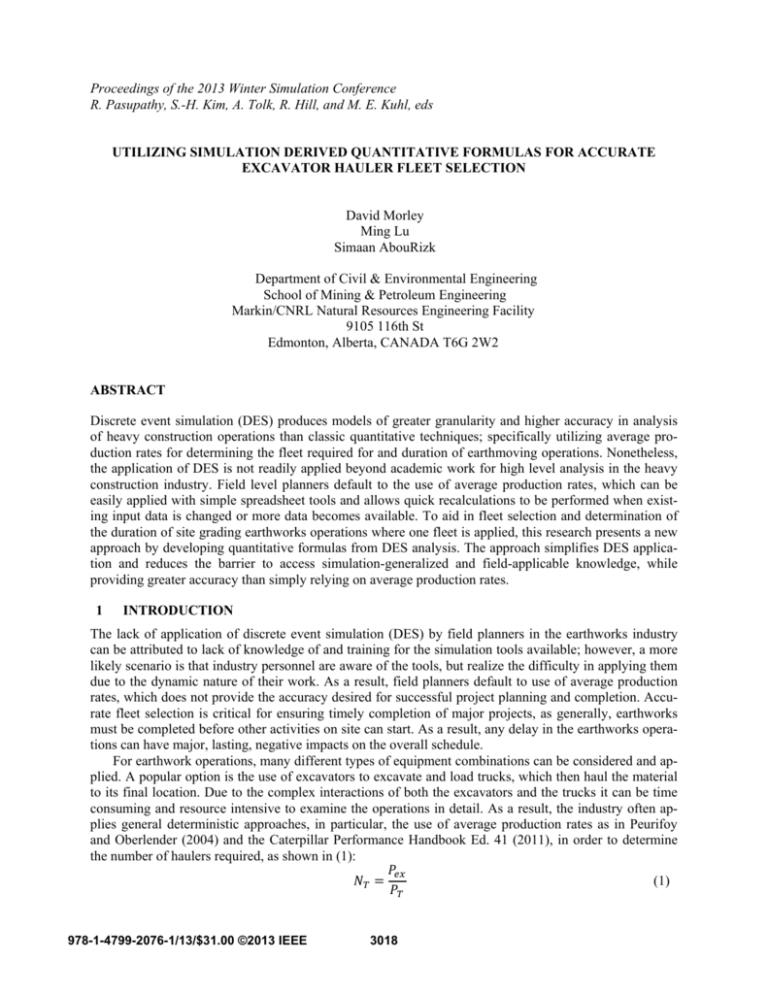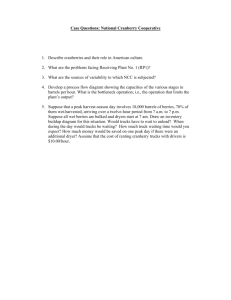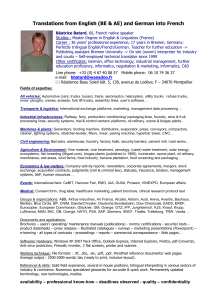utilizing simulation derived quantitative formulas for accurate
advertisement

Proceedings of the 2013 Winter Simulation Conference R. Pasupathy, S.-H. Kim, A. Tolk, R. Hill, and M. E. Kuhl, eds UTILIZING SIMULATION DERIVED QUANTITATIVE FORMULAS FOR ACCURATE EXCAVATOR HAULER FLEET SELECTION David Morley Ming Lu Simaan AbouRizk Department of Civil & Environmental Engineering School of Mining & Petroleum Engineering Markin/CNRL Natural Resources Engineering Facility 9105 116th St Edmonton, Alberta, CANADA T6G 2W2 ABSTRACT Discrete event simulation (DES) produces models of greater granularity and higher accuracy in analysis of heavy construction operations than classic quantitative techniques; specifically utilizing average production rates for determining the fleet required for and duration of earthmoving operations. Nonetheless, the application of DES is not readily applied beyond academic work for high level analysis in the heavy construction industry. Field level planners default to the use of average production rates, which can be easily applied with simple spreadsheet tools and allows quick recalculations to be performed when existing input data is changed or more data becomes available. To aid in fleet selection and determination of the duration of site grading earthworks operations where one fleet is applied, this research presents a new approach by developing quantitative formulas from DES analysis. The approach simplifies DES application and reduces the barrier to access simulation-generalized and field-applicable knowledge, while providing greater accuracy than simply relying on average production rates. 1 INTRODUCTION The lack of application of discrete event simulation (DES) by field planners in the earthworks industry can be attributed to lack of knowledge of and training for the simulation tools available; however, a more likely scenario is that industry personnel are aware of the tools, but realize the difficulty in applying them due to the dynamic nature of their work. As a result, field planners default to use of average production rates, which does not provide the accuracy desired for successful project planning and completion. Accurate fleet selection is critical for ensuring timely completion of major projects, as generally, earthworks must be completed before other activities on site can start. As a result, any delay in the earthworks operations can have major, lasting, negative impacts on the overall schedule. For earthwork operations, many different types of equipment combinations can be considered and applied. A popular option is the use of excavators to excavate and load trucks, which then haul the material to its final location. Due to the complex interactions of both the excavators and the trucks it can be time consuming and resource intensive to examine the operations in detail. As a result, the industry often applies general deterministic approaches, in particular, the use of average production rates as in Peurifoy and Oberlender (2004) and the Caterpillar Performance Handbook Ed. 41 (2011), in order to determine the number of haulers required, as shown in (1): (1) 978-1-4799-2076-1/13/$31.00 ©2013 IEEE 3018 Morley, Lu, and AbouRizk where is the production rate of the excavator in bank cubic meters per hour (bcm/hr), is the producis the number of trucks required. It is common practice to consider tion rate of the truck (bcm/hr) and up and down to an integer value and using a cost analysis to finalize the sugthe case of rounding gested number of trucks. The production rate of the truck can be determined as in (2): (2) is the truck volume (bcm) and is the total cycle time of the truck (h) which can be calculated where as in (3): (3) loadingtime roundtriptraveltime dumptime The duration of the project can then be calculated by dividing the quantity to be moved by either the production of the excavator or the production of the trucks , whichever is lower. It has previously been shown that this approach can be inaccurate and provides misleading decision support advice in regards to fleet selection. A poorly selected fleet greatly reduces the chances of success for an earthwork operation. Substantial research has been conducted in order to devise cost-effective quantitative methods and assist in determining the most appropriate fleet configuration for an earthmoving project. Touran and Taher (1988) applied queuing theory to select the optimum fleet size using constant time duration inputs. Shi and AbouRizk (1994, 1998), Smith et al. (1995), Hajjar and AbouRizk (1997), Martinez (1998), Marzouk and Moselhi (2002a, 2003b) and Alshibani and Moselhi (2012) applied DES to earthmoving operations. Christian and Xie (1996) constructed and used an expert system to determine the most appropriate fleet. Gransberg (1996) used a deterministic method of dividing the cycle time by the loading time of the trucks in order to determine the required number of haulers. Shi (1999) and Schabowicz and Hola (2007) used neural networks in order to determine the number of haulers required for a particular excavator. Smith (1999) estimated the productivity of earthmoving operations using linear regression techniques. Marzouk and Moselhi (2002b, 2003a, 2004) and Moselhi and Alsihibani (2009) applied genetic algorithms to determine the earthmoving fleet. Han et al (2008) applied simulation and multiple regression analysis for planning earthmoving systems. Zhang (2008) used particle swarm optimization for multi-objective optimization of earthmoving operations. Cheng et al. (2011) applied a perti net model for earthmoving operations. Yet, the method of average production rates (Peurifoy and Oberlender, 2004) is still widely taught at post-secondary institutions and is the most predominantly applied method in the field. This can be directly attributed to the ease of application. With this in mind, we present a new early stage fleet selection and estimating method which uses simulation to derive quantitative formulas accounting for the effect of distance and volume to be moved on earthwork project durations and the required resources. This method maintains the accuracy associated with detailed simulation models, far surpassing the accuracy of using classic average production rate techniques, while allowing repeatability not often found in simulation (Kannan et al. 2000) and maintaining the ease of application by front line personnel who may not have appropriate simulation training or cannot afford the time required for simulation modeling. To accommodate the changing situations from project to project, different quantitative formulas can be constructed in order to sufficiently address the range of work normally encountered by a specific contractor. These formulas can then be applied as easily and quickly as average production rates, and require much less time and resources than construction of a detailed simulation model. In high-risk scenarios or other complicated situations where a detailed simulation model is desired, the formulas serve as starting points in evaluating different fleet configurations, reducing the number of options to be considered. This correlates directly with reducing simulation time and resources. The new approach is applied to determine the required excavator and hauler fleet for a known volume and haul distance earthmoving operation. The approach is compared with average production rates and detailed simulation. The “danger” associated with using average production rates is clearly illustrated, and situations where detailed simulation is required or should be applied are clearly identified. This new 3019 Morley, Lu, and AbouRizk method does not replace detailed simulation, but rather compliments and assists in detailed simulation, offering an easier path of implementation in industry. At least, the insight gained points out great room for improvement in the current practice of using average production rates. 2 2.1 CONSTRUCTION OF THE FORMULAS Excavation Time The excavation time for a large volume of material can be approximated by a continuous function as in (4): dist (4) where , is the duration in minutes for one bank cubic meter of material to be excavated and loaded, dist is the numis the average of the supplied cycle time distribution of the specific excavator in minutes, ber of buckets required to fill the truck and is the capacity of the truck in bank cubic meters. 2.2 Number of Trucks Required The number of trucks required to ensure the excavator is the governing resource, defined as the resource that limits system production, is dependent on the specific excavator being used, the specific truck type being considered and the haul distance. A continuous function, , is constructed for each excavator and truck combination, using custom Monte Carlo simulation code implemented in MATLAB. A flowchart of the simulation is shown in Figure 1: INPUTS Excavator Type Truck Type Start Distance (m) End Distance (m) Distance step, Δd (m) SIMULATION Create N trucks Observe M loads Create N+1 trucks Observe M loads Trucks required = N+1 Distance <= End Distance Record inter-arrival time between loads at dump Record inter-arrival time between loads at dump QUIT Trucks required = N N=N -Inter-arrival time of N trucks -Inter-arrival time of N+1 trucks z-score is greater than critical value Compare inter-arrival times of N trucks vs. N+1 trucks using standard upper-tail z-score test. Distance = Distance + Δd else OUTPUTS else Figure 1: Simulation Flowchart. The simulation starts with the number of trucks, , equal to two, and the haul distance set to ensure the excavator will be the limiting resource. This is confirmed using the z-score test, described later. The simulation observes dumped loads for two cases: 1) hauling with trucks and 2) hauling with 1 trucks. The mean and variance of the inter-arrival time of the dumped loads are calculated for both cases. The distance is then increased by a step, ∆ . Dump time is considered to be integrated with the travel time of the trucks. A standard one-sided z-score test with 95% confidence is then used to determine if the mean inter-arrival times of both cases cannot be considered equal. The z-score statistic is calculated as shown in (5): 3020 Morley, Lu, and AbouRizk (5) where is the mean inter-arrival time for trucks, is the variance of the inter-arrival time for trucks, is the mean inter-arrival time for 1 trucks, is the variance of the inter-arrival time for 1 trucks and is the number of observations. If the returned z-statistic is greater than 1.645, then 1 trucks are required at the current distance to ensure that the excavator is the governing resource. is then equal to 1 and the simulation is repeated at the next distance, ∆ . The results are recorded to identify the largest haul distance where the excavator is the governing resource for each specific number of trucks and plotted as the number of trucks vs. distance and a linear regression performed in order to obtain a quantitative, continuous formula, , which takes for input the haul distance and returns the number of trucks required for the excavator to be the governing resource. The confidence interval of the returned y value of the regression, the required number of trucks for a given distance, is determined as in (6): ∆ where , ∑ , (6) ̅ is the t-value for a specified confidence level of 1 with , degrees of freedom, is 2, and ̅ is the mean of the x values. the standard error of the y variable, 2.3 ̅ 1 , Calculating Project Duration and Project Cost The total cost of the earthmoving operation can be calculated as in (7): is the total cost ($), is the cost to import/export material ($), where is the overhead cost of the project. is calculated as in (8): and (7) is the cost due to equipment (8) is the cost to export one bank cuwhere is the cost to import one loose cubic meter of material ($), is the amount of material in loose cubic meters to be imported, is the bic meter of material ($), amount of material in bank cubic meters to be exported. To calculate the equipment cost, , and the overhead cost, , two cases need to be considered: 1) the excavator as the governing resource, and 2) the trucks as the governing resource. 2.3.1 Excavator as the Governing Resource In the case of the excavator being the governing resource, the duration of the project depends directly on the amount of time required for the excavator to excavate and load the material. The duration in this case can be calculated as in (9): duration h (9) 60 is the total amount of material in bank cubic meters to be moved, is the number of excavawhere tors to be used and is the efficiency factor. The equipment cost, , can then be calculated as in (10): (10) 60 is the required number of trucks at the given average haul distance, , in meters, is the where is the hourly cost for the selected excavator ($), is the hourhourly cost for the selected trucks ($), ly cost for the selected dozer ($), is the hourly cost for the selected compactor ($), is the hourly cost for the grader ($), is the associated flat rate setup cost for the equipment ($). The overhead cost, , can be calculated as in (11): 3021 Morley, Lu, and AbouRizk where is the daily indirect cost ($) and (11) 60 is the hours per day to be worked. 2.3.2 Trucks as the Governing Resource The calculations in the case where the trucks are the governing resource are more complicated than in the case of the excavator being the governing resource. It is noted that there exists a haul distance, call it ∗ , where the production rates for both the excavator and the specific number of trucks are precisely matched. , inputting the number of trucks, and solv∗ can be calculated by taking the appropriate formula for ing for the distance, and therefore, the following relationship holds: #trips 1 (12) min is the capacity of the truck in bank cubic meters, and is the number of trucks to be used. where Then: min (13) trip The average speed of the trucks, in meters per minute, for the cycle can then be calculated as: 2 ∗ (14) speed and the truck cycle time as: 2 cycle (15) speed The duration of the project can then be calculated as: cycle duration h duration h 60 2 60 speed 2 2 60 60 ∗ ∗ (16) . Knowing the project duration allows for calculation of the equipment cost, . is calculated as in (17): , and the overhead cost, . 60 ∗ is calculated as follows in (18): (17) (18) 60 ∗ The dozer and compactor are selected automatically by looking at the overall production rate of the system. The production rate is calculated as in (19): totalvolumetobemoved bcm (19) overallproductionrate durationoftheproject h 3022 Morley, Lu, and AbouRizk 3 VALIDATION OF THE METHOD THROUGH CONSIDERATION OF A TEST CASE The earthwork haul to be considered involves an average haul distance of 3 km and 100,000 bank cubic meters of material to be moved. The material considered has no appreciable swell. One fleet will be used to perform the work. Four excavators are considered to perform the earthwork operations. Specifications were taken from the Caterpillar Performance Handbook Ed. 41 (2011) and can be found below in Table 1. For all four excavators, the amount of time required to excavate and load one cubic meter of material into a 6.12 bank cubic meter capacity tandem axel gravel truck, F , was calculated. Additionally, F was also calculated for loading an 18.5 bank cubic meter capacity articulated truck. An efficiency factor of 100% was considered. It should be noted that if the same efficiency factor is applied to the trucks and the excavator, the factor is cancelled out in the calculation of the fleet size. Note that NB stands for number of buckets to fill. Table 1: Excavator Capacity and Cycle Times. Excavator CAT 320 CAT 336 CAT 345 CAT 385 Capacity (bm3) 0.84 1.53 2.29 3.82 Min (min) 0.17 0.23 0.2 0.2 Mid (min) 0.30 0.33 0.33 0.40 High (min) 0.40 0.45 0.48 0.70 Avg (min) 0.29 0.34 0.34 0.43 NB GT 8 4 3 2 FV GT 0.38 0.22 0.17 0.14 NB RT 22 12 8 5 FV RT 0.34 0.22 0.15 0.12 The 6.12 bank cubic meter capacity trucks (GT) were considered to have the following speeds found in Table 2, represented by a triangular distribution. No differentiation was used between loaded and empty haul speeds. Table 2: Gravel Truck Speeds. Parameter Min Mode Max km/h 24 43 48 m/min 400 717 800 The 18.5 bank cubic meter capacity articulated trucks (RT) were considered to have the following speeds, found in Table 3, represented by a triangular distribution. Again, specifications were taken from the Caterpillar Performance Handbook Ed. 41 (2011). Table 3: Rock Truck Speeds. Parameter Min Mode Max loaded km/h m/min 13 220 24 400 56 933 unloaded km/h m/min 28 467 43 720 58 960 Using the above information, F was constructed for each excavator and truck combination. The simulation was tested using two different random number generators available in MATLAB, the Mersenne twister and the combined recursive algorithm. In order to ensure repeatability of the results, 100 million observations were required. The associated graphs for the case of the excavators with the rock trucks can be found below in Figure 2. 3023 Morley, Lu, and AbouRizk Figure 2: Required Number of Rock Trucks by Haul Distance. Table 4 identifies the hourly rates and associated setup costs for all equipment considered to move the material. Table 4: Setup and Hourly Costs for Various Equipment. Equipment 320 Excavator 336 Excavator 345 Excavator 385 Excavator 6.12 m3 truck 18.5 m3 truck CP323 CP433 CP56 D6N D6T D7T D8T D9T 14H Hourly Rate ($) 155 215 250 394 120 200 103 133 150 172 196 219 265 328 235 Setup ($) 2500 3000 3500 4000 240 3000 2000 2000 2000 2000 2000 2500 2500 3000 500 As mentioned earlier, the dozer and packer are selected automatically by looking at the overall production rate of the system. The maximum capabilities of the dozer and packer have been determined from data in the Caterpillar Performance Handbook Ed. 41. (2011) and are shown in Table 5. If the production rate required is greater than the largest available machine, then multiples of the largest machine are used. It is assumed that one 14H grader is always necessary on site. 3024 Morley, Lu, and AbouRizk Table 5: Production Capabilities of Various Dozers and Compactors. Equipment CP323 CP433 CP56 D6N D6T D7T D8T D9T Type Compactor Compactor Compactor Dozer Dozer Dozer Dozer Dozer Production (bm3/h) 239 326 847 500 700 900 1050 1700 Various fleet configuration options were analyzed using the method presented above. The total cost calculated for each option involved only equipment costs; indirect and material costs are not considered, but can easily be considered by applying Equation 4. The lowest cost option was found to be two 345 excavators with fourteen rock trucks, one CP56 compactor, one 14H grader and one D7T dozer for a cost of $589,238. For all locally optimal fleet configurations (the lowest cost using a specific excavator and truck type), individual simulation models were built using the CYCLONE template in Simphony (Simphony.NET 4.0, 2012). An example is shown below in Figure 3 using six 320 excavators with 36 gravel trucks. Each unique excavator is assigned six specific gravel trucks. A truck can only begin to load when its assigned excavator is available. Once loading is completed, the excavator can begin loading another truck and the loaded truck begins the hauling task. Once unloaded, the truck moves into the return task. After the return task, the truck load is counted. All trucks loads of all excavators are counted together. The truck queues and waits for its assigned loading unit to be available. Figure 3: CYCLONE Model, Six 320 Excavators with 36 Gravel Trucks. 3025 Morley, Lu, and AbouRizk Durations obtained using Equation 6, when the excavator was the governing resource, and Equation 13, when the trucks were the governing resource, were compared with the mean duration of ten simulation runs and the % difference calculated. Results can be found in Table 7. Table 7: Quantitative Formulas vs. Classic Simulation. Ex. 320 320 336 336 345 345 385 385 320 320 336 336 345 345 385 385 Trucks Req. (quantitative # of Ex. Truck Lim. Res. formulas) 5 GT EX 35 6 GT Truck 36 3 GT EX 36 3 GT Truck 33 2 GT EX 30 2 GT Truck 28 3 GT EX 54 3 GT Truck 51 4 RT EX 16 7 RT Truck 21 3 RT EX 18 3 RT Truck 15 2 RT EX 16 2 RT Truck 14 1 RT EX 10 1 RT Truck 9 Dur. (h) Dur. (h) (eq. 9/16) Simulation % diff (1) (2) (1) vs. (2) 127 127 0 126 108 16 122 122 0 124 122 1 142 138 3 148 138 7 78 79 1 78 79 1 142 144 2 121 90 30 122 122 1 136 122 11 125 122 3 137 122 12 200 195 2 204 195 4 The number of trucks required and the associated duration for various fleet configurations were also calculated using the average production rate approach as found in Peurifoy and Oberlender (2004). Specific calculations can be found in Table 8. Table 8: Trucks Required by Applying Classic Average Production Rates. Ex. 320 336 345 385 320 336 345 385 Avg. Bucket Cycle Time (min) Truck NB 0.29 GT 8 0.34 GT 4 0.34 GT 3 0.43 GT 2 0.29 RT 22 0.34 RT 12 0.34 RT 8 0.43 RT 5 Ex. Avg. Time Req. to Fill Ex. Prod. Prod. Truck Rate Speed Truck Rate (min) (bm3/min) (bm3/h) (m/min) 2.32 2.64 158.28 639 1.36 4.50 270.00 639 1.02 6.00 360.00 639 0.86 7.12 426.98 639 6.38 2.90 173.98 623 4.08 4.53 272.06 623 2.72 6.80 408.09 623 2.15 8.60 516.28 623 Truck Travel Time (min) 9.39 9.39 9.39 9.39 9.63 9.63 9.63 9.63 Truck Cycle Time (min) 11.71 10.75 10.41 10.25 16.01 13.71 12.35 11.78 Truck Prod. Rate (bm3/h) 31.36 34.16 35.27 35.83 69.35 80.99 89.91 94.26 Trucks Req. per Ex. 5.05 7.90 10.21 11.92 2.51 3.36 4.54 5.48 The duration can be calculated using the average production rate approach as in (20) and (21). When the excavator is the governing resource: vol.tobemoved bm (20) dur. h #ofexcavators excavatorproductionrate bm /h And when the trucks are the governing resource: vol.tobemoved bm dur. h #oftrucks truckproductionrate bm /h (21) The results were then compared with the mean duration of ten simulation runs and the % difference calculated. Results can be found in Table 10. 3026 Morley, Lu, and AbouRizk Table 10: Average Production Rates vs. Classic Simulation. Ex. 320 320 336 336 345 345 385 385 320 320 336 336 345 345 385 385 4 4.1 Trucks Dur. (h) Dur. (h) # of Lim. Req. Classic Simulation % diff Ex. Truck Res. (classic) (3) (classic) (4) (3) vs. (4) 5 GT EX 30 126 129 2 6 GT Truck 30 106 122 14 3 GT EX 24 123 141 14 3 GT Truck 21 139 159 13 2 GT EX 22 139 151 8 2 GT Truck 20 142 163 14 3 GT EX 36 78 90 15 3 GT Truck 33 85 97 14 4 RT EX 12 144 156 8 7 RT Truck 14 103 126 20 3 RT EX 12 123 137 12 3 RT Truck 9 137 176 25 2 RT EX 10 123 149 20 2 RT Truck 8 139 182 27 1 RT EX 6 194 240 21 1 RT Truck 5 212 282 28 CONCLUSIONS Excavator as the Governing Resource For the case of the excavator as the limiting resource, the newly presented simulation derived quantitative formulas provide outputs that are for all intents and purposes equal to the outputs provided by the detailed simulation models. While derivation of the quantitative formulas does take time, the investment to do so can be easily justified by the repetition of use that they provide unlike detailed simulation models which are generally only applied once or twice before needing modification. Additionally, the formulas provide the opportunity for rapid deployment at the field level as essentially no simulation knowledge is required and can be applied simply through paper and pencil. The quantitative formulas offer the same simplicity as the classical average production rate with the accuracy found in detailed simulation models. It must be noted that the classic average production rate method results in selection of fleets that are (1) severely under-trucked, (that is to say that there are not enough trucks selected to actually result in achieving the duration estimated by the method) and (2) underestimated in terms of project duration given the identified fleet (underestimated as much as 28%). This is a significant danger, as often, fleet allocation is made earlier in project planning and for most resource constrained contractors later acquisition/mobilization of more trucks to site can invoke significant unplanned and unforeseen costs, which are needed as trade-off to recover the project schedule. By offering a solution that is impossible to achieve in reality, the use of classic average production rates is not justifiable and will entrain serious consequences. 4.2 Trucks as the Governing Resource For the case of the trucks being the limiting resource, the quantitative formulas do suffer from similar inaccuracies as classic average production rate methods; however, there is one important difference. The use of quantitative formulas overestimates the project duration, whereas the classic average production rates once again underestimate the project duration. Again, classic average production rates methods provide fleet configuration solutions that cannot in reality obtain the estimated project duration. The solution provided by the quantitative formulas, however, can actually be obtained, in fact surpassed, in reality. It is arguable that this is the much better position to be in at the early stages of estimation and project planning. It has been shown that for an accurate estimate of project duration when the trucks are the limiting resource, the application of detailed simulation modeling is required. The quantitative formulas shown can assist in this process, by providing a clear starting point for fleet selection. For example, by simply look- 3027 Morley, Lu, and AbouRizk ing at the case of the excavator as the limiting resource, certain excavator and truck combinations may be able to be eliminated instantly without further consideration due to their high cost. Then, the remaining excavator truck combinations can be further refined through use of detailed simulation models. The starting point for each model would be one less truck for each excavator truck combination suggested by the quantitative formulas. The truck is now the limiting resource. The simulation can be run, the duration recorded and the time/cost trade-off evaluated. The process can be repeated for the suggested number of trucks less two and so forth. By this approach, the simulation expert is provided with a concrete starting point for the number of trucks to consider, and must only run simulations for scenarios with less than that number of trucks. In contrast, the early stage estimating based on classic average production rates provides no bounds relating to the true actual optimum number of trucks required. The presented method offers a new approach to fleet selection and determination of the duration of earthmoving operations, where one fleet is applied. The application clearly illustrates that a decrease in production does not directly correlate with an increase in project cost. It is significantly more accurate than the use of classic average production rates and allows for easy early stage estimation, planning and selection of a fleet in order to maximize production while minimizing total project cost. The method also serves to compliment detailed simulation, providing a clear starting point in considering the time-cost trade-off which occurs when the excavator is no longer the governing resource in the earthmoving production system. ACKNOWLEDGEMENTS David Morley would like to acknowledge the work done by Lance Cooper and Veronica Haring in establishing the base idea presented in this paper during the graduate course CIV E 606 at the University of Alberta, Winter 2012. REFERENCES Alshibani, A. and Moselhi, O. (2012). “Fleet selection for earthmoving projects using optimization-based simulation.” Can. J. Civ. Eng., 39, 619-630. Cheng, F.F, Wang, Y.W., Ling, X.Z. and Bai, Y. (2011). “A Petri net simulation model for virtual construction of earthmoving operations.” Automat. Constr., 20, 181-188. Christian, J. and Xie, T.X. (1996). “Improving earthmoving estimating by more realistic knowledge.” Can. J. Civ. Eng., 23, 250-259. Gransberg, D.D. (1996). “Optimizing haul unit size and number based on loading facility characteristics.” J. Constr. Eng. Manage., 122(3), 248-253. Hajjar, D. and AbouRizk, S. (1997). “AP2-Earth: a simulation based system for the estimating and planning of earth moving operations.” Proc., 29th Winter Simulation Conf., IEEE, Piscataway, NJ, 11031110. Han, S., Hong, T. and Lee, S. (2008). “Production prediction of conventional and global positioning system-based earthmoving systems using simulation and multiple regression analysis.” Can. J. Civ. Eng., 35, 574-587. Martinez, J. (1998). “Earthmover-simulation tool for earthwork planning.” Proc., 30th Winter Simulation Conf., IEEE, Piscataway, NJ, 1263-1272. Marzouk, M. and Moselhi, O. (2002a). “Simulation optimization for earthmoving operations using genetic algorithms.” Const. Manag. Econ., 20, 535-543. Marzouk, M. and Moselhi, O. (2002b). “Bid preparation for earthmoving operations.” Can. J. Civ. Eng., 29, 517-532. Marzouk, M. and Moselhi, O. (2003a). “Constraint-based genetic algorithm for earthmoving fleet selection.” Can. J. Civ. Eng., 30, 673-683. 3028 Morley, Lu, and AbouRizk Marzouk, M. and Moselhi, O. (2003b). “Object-oriented simulation model for earthmoving operations.” J. Constr. Eng. Manage., 129(2), 173-181. Marzouk, M. and Moselhi, O. (2004). “Multiobjective optimization of earthmoving operations.” J. Constr. Eng. Manage., 130(1), 105-113. Moselhi, O. and Alshibani, A. (2009). “Optimization of earthmoving operations in heavy civil engineering projects.” J. Constr. Eng. Manage., 135(10), 948-954. Peurifoy, R.L., and Oberlender, G.D. (2004). “Earthwork and Excavation”. Estimating Construction Costs, Fifth Edition, McGraw-Hill, New York, New York. Schabowicz, K. and Hola, B. (2007). “Mathematical-neural model for assessing productivity of earthmoving machinery.” J. Civ. Eng. Manag., 13(1), 47-54. Shi, J. and AbouRizk, S.M. (1994). “A resource based simulation approach with application in earthmoving/strip mining.” Proc., 26th Winter Simulation Conf., IEEE, Piscataway, NJ, 1124-1129. Shi, J. and AbouRizk, S.S. (1998). “An automated modeling system for simulating earthmoving operations.” Comput.-Aided Civ. Infrastruct. Eng., 13, 121-130. Shi, J.J. (1999). “A neural network based system for predicting earthmoving production.” Const. Manag. Econ., 17, 463-471. Simphony .NET 4.0 version 4.0.0.106, (2012), (computer software), The University of Alberta, Edmonton, AB. Smith, S.D. (1999). “Earthmoving productivity estimation using linear regression techniques.” J. Constr. Eng. Manage., 125(3), 133-141. Touran, A. and Taher, K.A.H. (1988). “Optimum fleet size determination by queuing and simulation.” Const. Manag. Econ., 6, 295-306. Zhang, H. (2008). “Multi-objective simulation-optimization for earthmoving operations.” Automat. Constr., 18, 79-86. AUTHOR BIOGRAPHIES DAVID MORLEY is an MSc Student at the University of Alberta, Department of Civil Engineering, Hole School of Construction Engineering. He has spent ample time as a direct field level supervisor in the field of earthworks. He is currently a Senior Project Coordinator with Graham Earthworks. His research interests include mathematical modeling of construction operations and projects, simulation and meta modeling, with the goal of enabling the application of high level analytical techniques within the dynamic construction industry. His email address is dmorley@ualberta.ca, davidmo@graham.ca. MING LU is an Associate Professor in the Department of Civil & Environmental Engineering at the University of Alberta. His research interests are construction surveying and automation; operations simulation and scheduling in construction. His email address is mlu6@ualberta.ca. SIMAAN M. ABOURIZK holds an NSERC Senior Industrial Research Chair in Construction Engineering and Management at the Department of Civil and Environmental Engineering, University of Alberta, where he is a Professor in the Hole School of Construction. He received the ASCE Peurifoy Construction Research Award in 2008. His email address is abourizk@ualberta.ca. 3029







